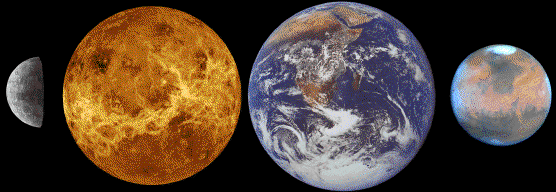ASTR 1210 (O'Connell)
TOPIC GUIDE/OUTLINE FOR THE
TERRESTRIAL PLANETS
 Mars Relief Map from the Mars Global Surveyor Mission.
Mars Relief Map from the Mars Global Surveyor Mission.Click for enlargement.
A. General Properties
- Near Sun (< 2 AU)
- Dense, rocky materials
- Well defined surfaces (unlike the Jovian planets)
- Atmospheres: None (Mercury, Moon) or thin (Earth, Mars, Venus) by the standards of the Jovian planets (although Venus' atmosphere is 90 times more massive than Earth's)
- Few satellites: Earth (1), Mars (2)
B. Exploration: mainly by space missions since 1960
- Mapping by spacecraft: all. Venus by radar.
- Robot landers: all but Mercury
- Human landings: Moon
- For a history of solar system exploration, both of the
terrestrial planets and other bodies, see:
- Calvin Hamilton's Exploration Page at "Views of the Solar System"
- This includes a chronology of space missions.
- It's worth noting that any space mission is a major undertaking and typically involves the skills of thousands of people. We have invested a great deal in our exploration of the solar system, but it has paid off in a much better understanding of our own environment.
C. Key Topics
- Earth's uniqueness & biosphere
- Earth interior & plate tectonics
- Moon: impact terrain
- Moon: surface history (from Apollo program) as clue to planet formation/evolution
- Venus: catastrophic resurfacing
- Venus: Greenhouse Effect
- Mars: topography & surface history
- Mars: evidence for water
- Mars: Meteorite evidence for life(?)
- Mars: the canal illusion and "the abode of life"; popular impact via The War of the Worlds; UFO's
- Earth/Venus/Mars: evolution of atmospheres; terrestrial climate change
-
Main Lesson: "little differences mean a lot"

Reading & Web Links:
-
See individual
Study Guides. Reading will cover Chapters
9 and 10 of the Bennett textbook
as well as The War of the Worlds.
 Previous Guide
Previous Guide
|
 Guide Index
Guide Index
|
 Next Guide
Next Guide
|